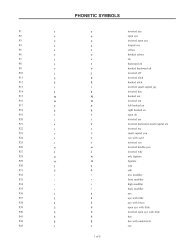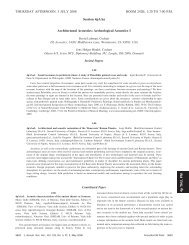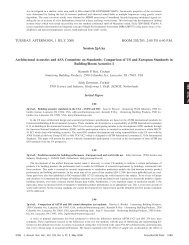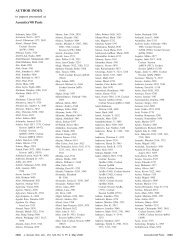Tuesday afternoon, 11 November - The Acoustical Society of America
Tuesday afternoon, 11 November - The Acoustical Society of America
Tuesday afternoon, 11 November - The Acoustical Society of America
Create successful ePaper yourself
Turn your PDF publications into a flip-book with our unique Google optimized e-Paper software.
produce high- and low-association tokens for each <strong>of</strong> 48 test sentences, split<br />
across three pretested lexical biases high bias, equibias, and low-association<br />
bias that were controlled for the number <strong>of</strong> syllables in the critical region.<br />
Results showed a significant lengthening difference between association<br />
conditions in the second noun, while the lengthening effect was minor in the<br />
first noun. In the high-association condition, the second noun region was<br />
significantly longer than the same region in the low-association condition.<br />
This is consistent with a stronger prosodic boundary at the end <strong>of</strong> the second<br />
conjunct for high-association productions than for low-association ones. <strong>The</strong><br />
interaction <strong>of</strong> lexical bias and association was not statistically significant,<br />
suggesting that speakers’ tendency to disambiguate through durational differences<br />
was not significantly affected by lexical bias.<br />
2pSC3. On the reliability <strong>of</strong> rhythm metrics. Amalia Arvaniti, Tristie<br />
Ross, and Naja Ferjan Dept. <strong>of</strong> Linguist., UCSD, 9500 Gilman Dr., La<br />
Jolla, CA 92093-D108, amalia@ling.ucsd.edu<br />
In the past decade or so, various metrics <strong>of</strong> vocalic and consonantal variability<br />
have been used to quantify linguistic rhythm, <strong>of</strong>ten yielding disparate<br />
results. <strong>The</strong> reliability <strong>of</strong> several such metrics percentage <strong>of</strong> vocalic intervals<br />
and consonantal standard deviation, pairwise variability indices, and<br />
variation coefficient was tested using materials from stress-timed English<br />
and German, syllable-timed Spanish and Italian, Korean, an unclassified language,<br />
and Greek, which has resisted classification. <strong>The</strong> materials for each<br />
language were divided into three subsets: an uncontrolled subset <strong>of</strong> sentences<br />
excerpted from a representative author <strong>of</strong> each language, a subset exhibiting<br />
as much as possible “stress-timing” properties complex syllable<br />
structure and extensive vocalic variability, and a subset exhibiting as much<br />
as possible “syllable-timing” properties simple syllable structure and limited<br />
vocalic variability. <strong>The</strong> results suggest that rhythmic scores can be severely<br />
affected by the choice <strong>of</strong> materials, especially in languages such as<br />
Italian, in which it is easy to avoid or accentuate variability e.g., by excluding<br />
or including geminates. Variation coefficient scores were the most resistant<br />
to the manipulation <strong>of</strong> materials but failed to show statistical differences<br />
across most <strong>of</strong> the languages examined. <strong>The</strong> overall results cast doubt<br />
on the reliability <strong>of</strong> metric scores as indicators <strong>of</strong> timing and linguistic<br />
rhythm.<br />
2pSC4. Impact <strong>of</strong> segmentation rules on the rhythm metrics. Diana<br />
Stojanovic Dept. <strong>of</strong> Linguist., Univ. <strong>of</strong> Hawaii, 1890 East-West Rd., Moore<br />
Hall 569, Honnolulu, HI 96822<br />
Rhythm <strong>of</strong> speech in the literature <strong>of</strong> the past decade is quantified using<br />
measures <strong>of</strong> durations: first order, such as mean duration and percentage <strong>of</strong><br />
the total sample, or second order, such as variance and pairwise variability<br />
index. Results <strong>of</strong> different studies, however, vary even when the same materials<br />
and speech mode are used and imply uncertainty <strong>of</strong> cross-study<br />
comparisons. Allen 1978 discussed the issue <strong>of</strong> validity the criteria used<br />
for segmenting and reliability how accurately these criteria can be applied<br />
on duration studies. <strong>The</strong> current paper examines how different segmentation<br />
criteria affect the five most commonly used rhythm metrics. All metrics are<br />
computed on the segmented sample <strong>of</strong> the read story <strong>The</strong> North Wind and<br />
the Sun for three speakers each <strong>of</strong> <strong>America</strong>n English, Indonesian, and<br />
Serbo-Croatian. Different segmentation criteria were applied to 1 borders<br />
between voiceless plosives and vowels and 2 borders between vowels and<br />
trills. As a result, durations <strong>of</strong> some segments were changed in the range <strong>of</strong><br />
10–50 ms. <strong>The</strong> results show how different metrics are affected by the choice<br />
<strong>of</strong> two segmentation rules at two different speech rates. Implications for<br />
cross-linguistic studies are discussed.<br />
2pSC5. A rough task: Defining a measure for rough voice quality. Rahul<br />
Shrivastav, David A. Eddins, Sona Patel, and Stacie Cummings Dept. <strong>of</strong><br />
Commun. Sci. and Disord., Univ. <strong>of</strong> Florida, Gainesville, FL 326<strong>11</strong><br />
Perceptual judgments <strong>of</strong> voice quality on a rating scale or a magnitude<br />
estimation task are highly context dependent, making it difficult to compare<br />
data from one experiment to another. In previous work, a matching task using<br />
a sawtooth wave mixed with speech-shaped noise was found useful for<br />
quantifying breathiness in vowels Patel et al., 2006, JASA, <strong>11</strong>9, 3340. In<br />
the present experiment, we attempted to adapt this matching task for the estimation<br />
<strong>of</strong> roughness in vowels. Ten listeners participated in a matching<br />
task where listeners compared the roughness <strong>of</strong> a voice standard and the reference<br />
signal. A low-pass filtered sawtooth wave mixed with speech-shaped<br />
noise was used as the reference signal. <strong>The</strong> roughness <strong>of</strong> this signal was manipulated<br />
by amplitude modulating the waveform with a 40-Hz square wave.<br />
<strong>The</strong> modulation depth at which the signal and standard were perceived to be<br />
equally rough was used as an index <strong>of</strong> vowel roughness. Preliminary results<br />
show that listeners are able to use the matching task to estimate roughness in<br />
vowels, particularly for moderately to severely roughness voices. However,<br />
voices with little or no roughness are difficult to match to the signal because<br />
<strong>of</strong> the inherent timbre <strong>of</strong> the sawtooth.<br />
2pSC6. Phonetic realization <strong>of</strong> prominence among lexical tones in<br />
Mandarin Chinese. Mingzhen Bao and Ratree Wayland Program in<br />
Linguist., Univ. <strong>of</strong> Florida, Gainesville, FL 32601, joanneb@ufl.edu<br />
Linguistic prominence is defined as words or syllables perceived auditorily<br />
as standing out from their environment Terken 1994. It is explored<br />
through changes in pitch, duration, and loudness Ladd 1996. In this study,<br />
phonetic realization <strong>of</strong> prominence was investigated among lexical tones in<br />
Mandarin Chinese. <strong>The</strong> primary concern was to compare how accent and<br />
focus are acoustically realized under four conditions: a unaccented and unfocused,<br />
b accented but unfocused, c unaccented but focused, and d accented<br />
and focused, among four tones. Ten native speakers <strong>of</strong> Chinese were<br />
recorded reading materials in a natural fashion. <strong>The</strong> recorded data were segmented<br />
and acoustically measured for acoustic parameters: vowel duration;<br />
mean and maximum <strong>of</strong> intensity; and mean, maximum, minimum, and slope<br />
<strong>of</strong> F0. <strong>The</strong> results showed that vowel duration lengthening was the main<br />
acoustic parameter associated with accent, while an increase in vowel duration,<br />
mean and maximum <strong>of</strong> intensity and F0, and slope <strong>of</strong> F0 was associated<br />
with focus realization. It was also found that acoustic parameters used<br />
to realize focus were differentially ranked and varied from tone to tone.<br />
<strong>The</strong>se results suggested that phonetic realization <strong>of</strong> prominence in Mandarin<br />
Chinese was affected by category <strong>of</strong> prominence i.e., focus or accent and<br />
tonal contexts.<br />
2pSC7. <strong>The</strong> relationship between open quotient and H1 * -H2 * . Jody<br />
Kreiman Div. <strong>of</strong> Head/Neck Surgery, UCLA School <strong>of</strong> Medicine, 31-24 Rehab<br />
Ctr., Los Angeles, CA 90095-1794, Markus Iseli, Juergen Neubauer,<br />
Yen-Liang Shue, Bruce R. Gerratt UCLA School <strong>of</strong> Medicine, Los Angeles,<br />
CA 90095-1794, and Abeer Alwan UCLA, Los Angeles, CA 90095<br />
It is widely assumed that changes in open quotient OQ produce corresponding<br />
changes in H1 * -H2 * , but empirical data supporting this relationship<br />
are scant. To provide such data, high-speed video images and audio signals<br />
were simultaneously recorded from six speakers producing the vowel /i/<br />
while varying F0 from high to low and voice quality from pressed to<br />
breathy. Across speakers, the observed relationship between OQ and<br />
H1 * -H2 * was much weaker than generally assumed. Patterns <strong>of</strong> covariation<br />
also differed substantially from speaker to speaker. Estimation <strong>of</strong> harmonic<br />
amplitudes was complicated by difficulties in determining the frequency <strong>of</strong><br />
F1 when F0 was high and by uncertainties regarding the F1 bandwidth in<br />
the presence <strong>of</strong> a persistent glottal chink. Use <strong>of</strong> analysis-by-synthesis allowed<br />
correction <strong>of</strong> formant values, but bandwidth estimation remains problematic<br />
and will be discussed further at the conference. Work supported by<br />
NIH Grant DC01797 and NSF Grant BCS-0720304.<br />
2pSC8. Music melody perception in tone-language- and<br />
nontone-language speakers. Jennifer A. Alexander, Ann R. Bradlow<br />
Dept. <strong>of</strong> Linguist., Northwestern Univ., 2016 Sheridan Rd., Evanston, IL<br />
60208, Richard D. Ashley, and Patrick C. M. Wong Northwestern Univ.,<br />
Evanston, IL 60208<br />
Speech and music both utilize pitch variation to convey contrasts in<br />
meaning: music-pitch expresses composition e.g., the key <strong>of</strong> a piece and<br />
effect; speech-pitch conveys pragmatic meaning and, in tone languages,<br />
lexical information. This study investigated whether experience with processing<br />
lexical pitch affects music pitch processing. 28 nonmusicians 14<br />
native English speakers and 14 native Mandarin speakers discriminated<br />
experiment 1 and identified experiment 2 short melodies. <strong>The</strong> Mandarin<br />
listeners more accurately discriminated the melodies than the English listeners<br />
Mann-Whitney U140.5, p0.05; two-tailed t21.862.45, p0.05,<br />
d0.93, but the English listeners more accurately matched the melodies<br />
with graphical representations <strong>of</strong> the pitch movements that the mandarin listeners<br />
Mann-Whitney U26.5, p0.005; two-tailed t25.443.94, p0<br />
.001, d1.15. This indicates that experience with lexical-pitch processing<br />
2495 J. Acoust. Soc. Am., Vol. 124, No. 4, Pt. 2, October 2008 156th Meeting: <strong>Acoustical</strong> <strong>Society</strong> <strong>of</strong> <strong>America</strong><br />
2495<br />
2p TUE. PM







